Boaz Barak
Stress Testing Deliberative Alignment for Anti-Scheming Training
Sep 19, 2025Abstract:Highly capable AI systems could secretly pursue misaligned goals -- what we call "scheming". Because a scheming AI would deliberately try to hide its misaligned goals and actions, measuring and mitigating scheming requires different strategies than are typically used in ML. We propose that assessing anti-scheming interventions requires at least (1) testing propensity to scheme on far out-of-distribution (OOD) tasks, (2) evaluating whether lack of scheming is driven by situational awareness, and (3) checking for robustness to pre-existing misaligned goals. We use a broad category of "covert actions" -- such as secretly breaking rules or intentionally underperforming in tests -- as a proxy for scheming, and design evaluations for covert actions. We then stress-test deliberative alignment as a case study for anti-scheming. Across 26 OOD evaluations (180+ environments), deliberative alignment reduces covert action rates (OpenAI o3: 13%->0.4%) but does not fully eliminate them. Our mitigation is also able to largely stop agents from pursuing a hidden goal previously trained into the model, but we still find misbehavior after additional red-teaming. We find that models' chain-of-thought (CoT) often demonstrates awareness of being evaluated for alignment, and show causal evidence that this awareness decreases covert behavior, while unawareness increases it. Therefore, we cannot exclude that the observed reductions in covert action rates are at least partially driven by situational awareness. While we rely on human-legible CoT for training, studying situational awareness, and demonstrating clear evidence of misalignment, our ability to rely on this degrades as models continue to depart from reasoning in standard English. We encourage research into alignment mitigations for scheming and their assessment, especially for the adversarial case of deceptive alignment, which this paper does not address.
Trading Inference-Time Compute for Adversarial Robustness
Jan 31, 2025



Abstract:We conduct experiments on the impact of increasing inference-time compute in reasoning models (specifically OpenAI o1-preview and o1-mini) on their robustness to adversarial attacks. We find that across a variety of attacks, increased inference-time compute leads to improved robustness. In many cases (with important exceptions), the fraction of model samples where the attack succeeds tends to zero as the amount of test-time compute grows. We perform no adversarial training for the tasks we study, and we increase inference-time compute by simply allowing the models to spend more compute on reasoning, independently of the form of attack. Our results suggest that inference-time compute has the potential to improve adversarial robustness for Large Language Models. We also explore new attacks directed at reasoning models, as well as settings where inference-time compute does not improve reliability, and speculate on the reasons for these as well as ways to address them.
OpenAI o1 System Card
Dec 21, 2024



Abstract:The o1 model series is trained with large-scale reinforcement learning to reason using chain of thought. These advanced reasoning capabilities provide new avenues for improving the safety and robustness of our models. In particular, our models can reason about our safety policies in context when responding to potentially unsafe prompts, through deliberative alignment. This leads to state-of-the-art performance on certain benchmarks for risks such as generating illicit advice, choosing stereotyped responses, and succumbing to known jailbreaks. Training models to incorporate a chain of thought before answering has the potential to unlock substantial benefits, while also increasing potential risks that stem from heightened intelligence. Our results underscore the need for building robust alignment methods, extensively stress-testing their efficacy, and maintaining meticulous risk management protocols. This report outlines the safety work carried out for the OpenAI o1 and OpenAI o1-mini models, including safety evaluations, external red teaming, and Preparedness Framework evaluations.
Deliberative Alignment: Reasoning Enables Safer Language Models
Dec 20, 2024Abstract:As large-scale language models increasingly impact safety-critical domains, ensuring their reliable adherence to well-defined principles remains a fundamental challenge. We introduce Deliberative Alignment, a new paradigm that directly teaches the model safety specifications and trains it to explicitly recall and accurately reason over the specifications before answering. We used this approach to align OpenAI's o-series models, and achieved highly precise adherence to OpenAI's safety policies, without requiring human-written chain-of-thoughts or answers. Deliberative Alignment pushes the Pareto frontier by simultaneously increasing robustness to jailbreaks while decreasing overrefusal rates, and also improves out-of-distribution generalization. We demonstrate that reasoning over explicitly specified policies enables more scalable, trustworthy, and interpretable alignment.
An Economic Solution to Copyright Challenges of Generative AI
Apr 24, 2024



Abstract:Generative artificial intelligence (AI) systems are trained on large data corpora to generate new pieces of text, images, videos, and other media. There is growing concern that such systems may infringe on the copyright interests of training data contributors. To address the copyright challenges of generative AI, we propose a framework that compensates copyright owners proportionally to their contributions to the creation of AI-generated content. The metric for contributions is quantitatively determined by leveraging the probabilistic nature of modern generative AI models and using techniques from cooperative game theory in economics. This framework enables a platform where AI developers benefit from access to high-quality training data, thus improving model performance. Meanwhile, copyright owners receive fair compensation, driving the continued provision of relevant data for generative model training. Experiments demonstrate that our framework successfully identifies the most relevant data sources used in artwork generation, ensuring a fair and interpretable distribution of revenues among copyright owners.
Distinguishing the Knowable from the Unknowable with Language Models
Feb 05, 2024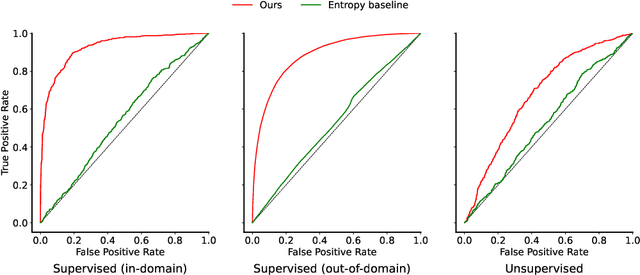
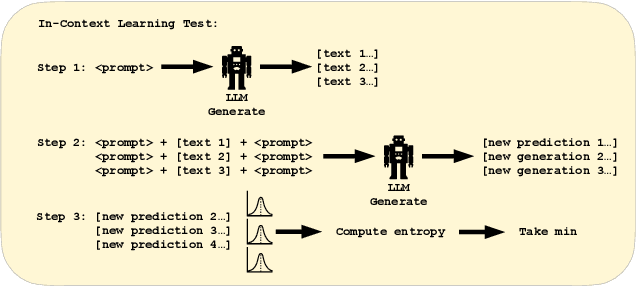
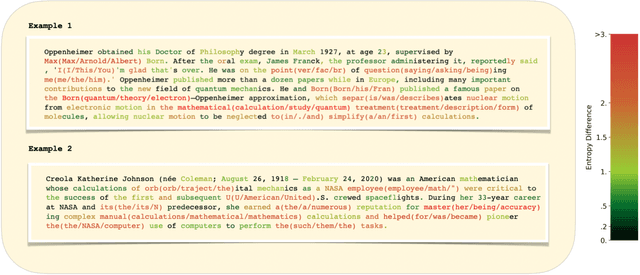
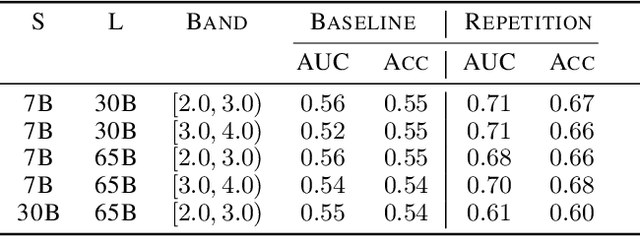
Abstract:We study the feasibility of identifying epistemic uncertainty (reflecting a lack of knowledge), as opposed to aleatoric uncertainty (reflecting entropy in the underlying distribution), in the outputs of large language models (LLMs) over free-form text. In the absence of ground-truth probabilities, we explore a setting where, in order to (approximately) disentangle a given LLM's uncertainty, a significantly larger model stands in as a proxy for the ground truth. We show that small linear probes trained on the embeddings of frozen, pretrained models accurately predict when larger models will be more confident at the token level and that probes trained on one text domain generalize to others. Going further, we propose a fully unsupervised method that achieves non-trivial accuracy on the same task. Taken together, we interpret these results as evidence that LLMs naturally contain internal representations of different types of uncertainty that could potentially be leveraged to devise more informative indicators of model confidence in diverse practical settings.
Watermarks in the Sand: Impossibility of Strong Watermarking for Generative Models
Nov 15, 2023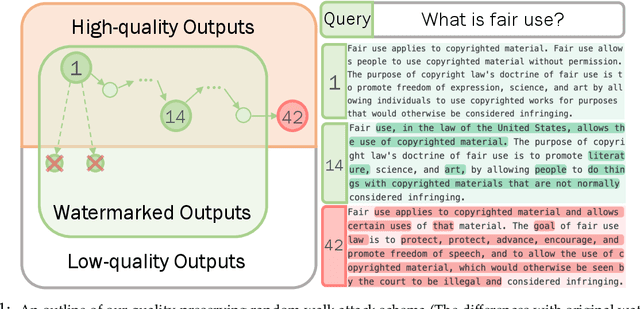



Abstract:Watermarking generative models consists of planting a statistical signal (watermark) in a model's output so that it can be later verified that the output was generated by the given model. A strong watermarking scheme satisfies the property that a computationally bounded attacker cannot erase the watermark without causing significant quality degradation. In this paper, we study the (im)possibility of strong watermarking schemes. We prove that, under well-specified and natural assumptions, strong watermarking is impossible to achieve. This holds even in the private detection algorithm setting, where the watermark insertion and detection algorithms share a secret key, unknown to the attacker. To prove this result, we introduce a generic efficient watermark attack; the attacker is not required to know the private key of the scheme or even which scheme is used. Our attack is based on two assumptions: (1) The attacker has access to a "quality oracle" that can evaluate whether a candidate output is a high-quality response to a prompt, and (2) The attacker has access to a "perturbation oracle" which can modify an output with a nontrivial probability of maintaining quality, and which induces an efficiently mixing random walk on high-quality outputs. We argue that both assumptions can be satisfied in practice by an attacker with weaker computational capabilities than the watermarked model itself, to which the attacker has only black-box access. Furthermore, our assumptions will likely only be easier to satisfy over time as models grow in capabilities and modalities. We demonstrate the feasibility of our attack by instantiating it to attack three existing watermarking schemes for large language models: Kirchenbauer et al. (2023), Kuditipudi et al. (2023), and Zhao et al. (2023). The same attack successfully removes the watermarks planted by all three schemes, with only minor quality degradation.
Beyond Implicit Bias: The Insignificance of SGD Noise in Online Learning
Jun 14, 2023Abstract:The success of SGD in deep learning has been ascribed by prior works to the implicit bias induced by high learning rate or small batch size ("SGD noise"). While prior works that focused on offline learning (i.e., multiple-epoch training), we study the impact of SGD noise on online (i.e., single epoch) learning. Through an extensive empirical analysis of image and language data, we demonstrate that large learning rate and small batch size do not confer any implicit bias advantages in online learning. In contrast to offline learning, the benefits of SGD noise in online learning are strictly computational, facilitating larger or more cost-effective gradient steps. Our work suggests that SGD in the online regime can be construed as taking noisy steps along the "golden path" of the noiseless gradient flow algorithm. We provide evidence to support this hypothesis by conducting experiments that reduce SGD noise during training and by measuring the pointwise functional distance between models trained with varying SGD noise levels, but at equivalent loss values. Our findings challenge the prevailing understanding of SGD and offer novel insights into its role in online learning.
Scaling Data-Constrained Language Models
May 25, 2023Abstract:The current trend of scaling language models involves increasing both parameter count and training dataset size. Extrapolating this trend suggests that training dataset size may soon be limited by the amount of text data available on the internet. Motivated by this limit, we investigate scaling language models in data-constrained regimes. Specifically, we run a large set of experiments varying the extent of data repetition and compute budget, ranging up to 900 billion training tokens and 9 billion parameter models. We find that with constrained data for a fixed compute budget, training with up to 4 epochs of repeated data yields negligible changes to loss compared to having unique data. However, with more repetition, the value of adding compute eventually decays to zero. We propose and empirically validate a scaling law for compute optimality that accounts for the decreasing value of repeated tokens and excess parameters. Finally, we experiment with approaches mitigating data scarcity, including augmenting the training dataset with code data or removing commonly used filters. Models and datasets from our 400 training runs are publicly available at https://github.com/huggingface/datablations.
Provable Copyright Protection for Generative Models
Feb 21, 2023Abstract:There is a growing concern that learned conditional generative models may output samples that are substantially similar to some copyrighted data $C$ that was in their training set. We give a formal definition of $\textit{near access-freeness (NAF)}$ and prove bounds on the probability that a model satisfying this definition outputs a sample similar to $C$, even if $C$ is included in its training set. Roughly speaking, a generative model $p$ is $\textit{$k$-NAF}$ if for every potentially copyrighted data $C$, the output of $p$ diverges by at most $k$-bits from the output of a model $q$ that $\textit{did not access $C$ at all}$. We also give generative model learning algorithms, which efficiently modify the original generative model learning algorithm in a black box manner, that output generative models with strong bounds on the probability of sampling protected content. Furthermore, we provide promising experiments for both language (transformers) and image (diffusion) generative models, showing minimal degradation in output quality while ensuring strong protections against sampling protected content.
 Add to Chrome
Add to Chrome Add to Firefox
Add to Firefox Add to Edge
Add to Edge